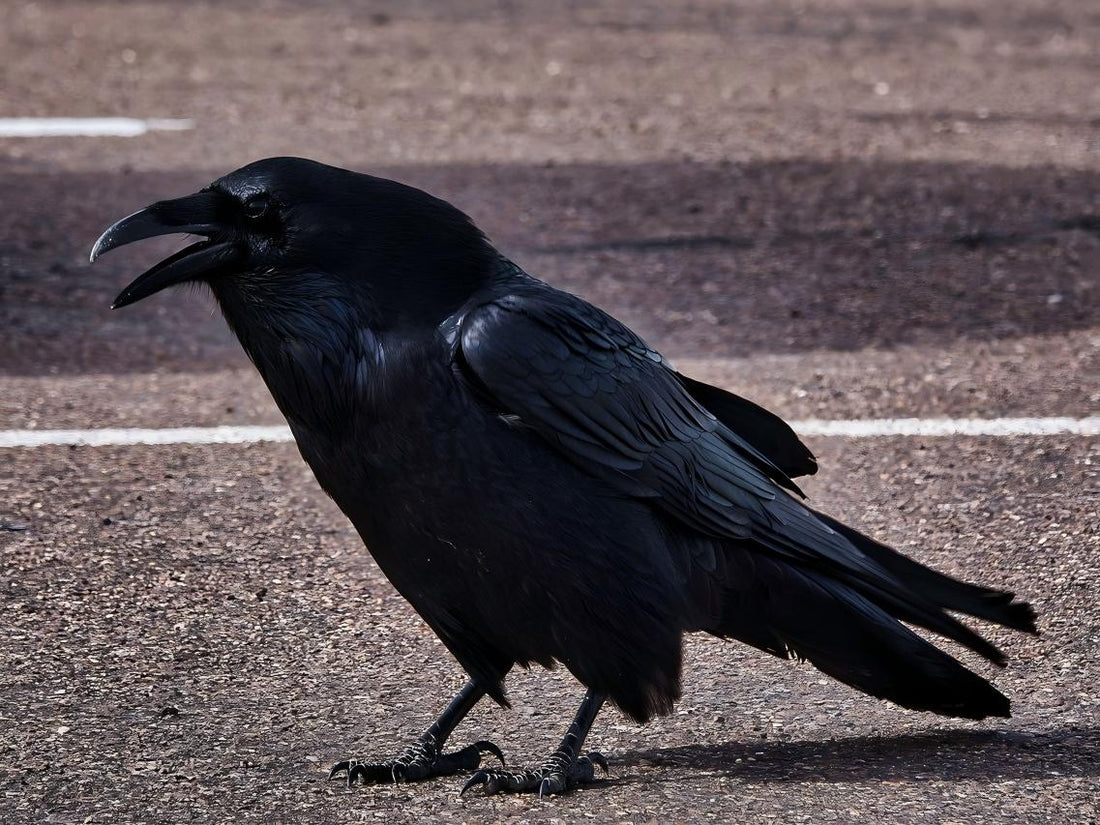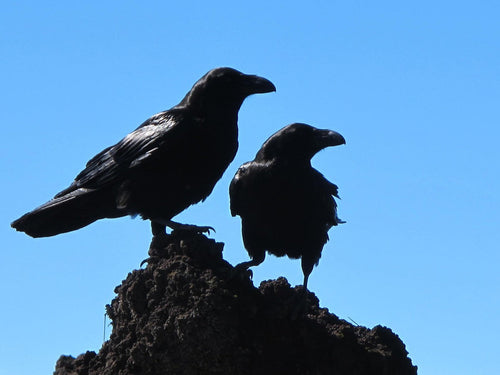What Is the Raven Meaning? Myths, Culture, and Signs
TTNatureTeam
Some birds captured human imagination deeply. Raven is one of them. This jet black corvid has been revered and feared equally in history. It has different meanings and symbols in different cultures.
Raven is symbolized as a horror sign and gives spooky vibes. In some cultures, the raven is remembered for its intelligence and mystique.
This article will tell you raven meanings, its symbols, and its value in modern culture. Let's discuss how people imagine this creature according to their beliefs.
What Does A Raven Mean?
The raven is the largest and heaviest species of the crow family. It consists of 24–27 inches in length. They have over 4 feet of wing span and around 3 pounds in weight.
Raven is found in the Northern Hemisphere. These areas include the Arctic tundra, deserts, forests, and urban cities. They are highly adaptable omnivores and mostly known as “arch scavengers”. Hence, can eat anything, like carrion, rodents, insects, seeds, fruit, garbage, and food waste.
The Raven's brain consists of brain cells and has advanced cognitive abilities. They can remember human faces, plan for the future and trick other animals. Further, they have an extensive vocal range and mimic other sounds. Ravens are also highly adaptable to so many environments due to their extraordinary intelligence. Due to all these abilities, people viewed this bird as a spirit guide of knowledge and a secret keeper.
What is Raven Symbolism in Different Cultures
The shiny black colored appearance and behavior of the raven create many myths and symbols. Many writers write different stories according to their imaginations. It is associated with life and death, creation and destruction, wisdom and trickery.
Norse Mythology
The people give respect to ravens for their wisdom and power of sight. The chief god Odin also has the meaning of Raven-God. Odin has two beloved rands named Huginn (“Thought”) and Muninn (“Memory”). They sat on his shoulders and flew around the world to gather information for him. These serve as a messenger, and Odin kept an eye on affairs between humans and Gods.
Ravens were also known as “beasts of battle. Viking warriors painted black ravens on their banners and sails to invoke Odin’s favor in war. This banner was considered a sign of victory. They also believed that Odin could shift his face into a raven or send his fylgja (spirit form) as a raven.
Celtic Traditions
There are many different stories of Celtic traditions from Ireland, Wales and Britain. The stories are symbols of war, sovereignty, and a link to the Otherworld. According to Celtic traditions, the Irish war goddess could take the form of a raven or crow and fly over battlefields. This goddess appears on the shoulder of the hero Cú Chulainn at his death.
There is another celtic diety called Brân the Blessed. He is a giant king and protects his people after death. According to some legend, the Bran head is buried under the hill where the Tower of London now stands. Many Celtic people believe bad things will happen to Britain if ravens leave the tower. In fact, during WWII, Winston Churchill kept the healthy population of ravens at the Tower despite the Blitz.
In Cornish folklore, people believe that the soul of King Arthur transformed into the raven. They also think Arthur lives as a raven, and killing a raven could bring bad luck. These tales show the raven as a protector of the realm and a link between the royal lineage and the land.
Native American and First Nations Myths
The raven is very important in the native american traditions. People in Alaska and canade costs tell multiple creation and trickster stories. In these stories, they make raven as a powerful cultural hero with these roles.
When the world stayed dark because a strong leader locked up the sun, moon, and stars. Raven was smart and opened the containers and freed the sun, moon, and stars. He then put them in the sky to light up the world and satisfy his own curiosity.
People who live on the Pacific Northwest Coast see Raven as a Trickster who is like Coyote from Plains mythology and Loki from Norse mythology. Raven has two personalities who create things by accident and save the world.
Raven teaches people about life through his mistakes and actions. Native American honor the raven as a sacred animal because it represents the sun and the creator of the world. This is shown on totem poles and formline paintings.
According to Cherokee mythology, the Raven Mocker (Kâ’lanû Ahkyeli’skï) exists as a wicked spirit that transforms into a raven to hunt down people who are ill or dying. The Raven Mocker appears during nighttime with flames on its body while making raven sounds to steal hearts from sick people.
Raven Mockers remain invisible to most people but medicine men who possess expertise can detect them and perform protection rituals against these creatures. The true form of the Raven Mocker becomes visible to people only when they see it but this revelation leads to its death within seven days.
The witch creature known as Raven Mocker exists as a frightening entity in some indigenous traditions because it brings death and dark magic to its victims.

Greco-Roman and Biblical Traditions
Greece Traditions
In the classical Greece and Rome, ravens played positive and sometimes negative character. Greek mythology linked the raven to Apollo, the god of prophecy. They believed ravens were Apollo’s sacred birds and messengers in the mortal realm.
Apollo has pure white raven as a pet. He sent this to spy on his lover coronic. Raven brings news that coronis is unfaithful. After hearing this apollo cursed the raven in anger and scorched its feathers. Thus the raven’s plumage turned black forevermore. Through this myth, the Greeks explained why ravens are black, and they also cast the raven as a bearer of truth (albeit bad news).
Another Greek legend said ravens were once humans and his name was Lycius. Apollo saved him from attackers and he was transformed into a raven. In Greece the raven was seen as a prophetic and wise bird. But also a bird of ill omen if it croaked on your left side.
Roman Stories
Similarly, Romans practised augury and the direction of a raven’s call or flight could signal good or bad fortune. An old Latin proverb “corvus oculus corvi non effodiet” (“a raven will not peck out the eye of another raven”) meant honor among thieves.
One famous Roman legend Marcus Valerius Corvus. According to Livy, during a duel between Valerius and a gigantic Gallic warrior, a raven suddenly appeared and perched on Valerius’s helmet. The bird then dive-bombed the Gaul, pecking at his eyes and confusing him. Hence it allows Valerius to strike the killing blow. Victorious, Valerius adopted the cognomen Corvus (“Raven”) in honor of the miraculous helper.
Judeo-Christian Tradition
In Judeo-Christian tradition, ravens appear with ambivalent meaning. The raven is actually the first bird mentioned in the Bible: in Genesis 8:7. Noah releases a raven from the Ark after the Flood to see if the waters had receded. The raven “went to and fro until the waters were dried up,” and unlike the dove, it did not return immediately. Because of this, some early theologians like St. Augustine viewed the raven as a symbol of lack of faith or disobedience.
Under the Law of Moses, ravens were listed among the unclean creatures that Israelites should not eat (Leviticus 11:15, Deuteronomy 14:14). This taboo may have cast a negative light on the raven as impure or associated with death. Indeed, later Jewish folklore (e.g. the Talmud) even suggested the raven was cursed for improper behavior on the Ark.
Yet, paradoxically, ravens also serve as instruments of God’s providence in the Bible. In 1 Kings 17:4–6, during a famine, the prophet Elijah is fed bread and meat by ravens sent by God to sustain him in the wilderness.
Other Cultures
Other cultures around the world have their own raven lore as well.
In Chinese mythology, the Three-Legged Raven (or crow) is a solar symbol called sanzuwu lives in the sun and represents its three stages (rising, noon, setting)
In Australia, Aboriginal myths tell of Raven (sometimes called Waarragul or by other names) who was originally white but was charred black when he stole fire from the sky to give to humans.
The Egyptians linked ravens to destruction and unrest, and Arabs gave the raven the nickname Abu Aajir – “Father of Omens”. It implies that seeing one meant a significant (usually bad) event was coming. However, not all omens were bad; some Arab folklore also saw the raven as a wise guide in the desert.
In Tibet and Bhutan, ravens are revered as divine messengers. The royal crown of Bhutan is the Raven Crown, topped by a raven’s head representing the god Mahakala (a protector deity). And in Tibetan, the Raven-Faced Mahakala, who guards the faith. This protective raven spirit is a far cry from the ill-omened raven of Europe.
Is the Raven Wise or Trickster?
Ravens can be both good and bad, wise and tricky, fearful and helpful. This is called duality.
● It eats dead animals, which seems dark and scary. But this also helps nature recycle life.
● Ravens are black like night, but they fly in daylight.
● They sound harsh, but copy human voices as trickster
● Ravens are very smart, they use tools to get food.
● They can remember human faces and know who is kind or mean.
● Ravens work together to solve problems and sometimes plan for the future.
The Raven Meaning in Literature and Art
There are multiple stories, poems and songs about ravens. Most writers use their names to build their soties. They show mystery, magic, sadness, or wisdom.
Edgar Allan Poe wrote a poem named The Raven. In this poem, a raven visited a sad man and spoke one word, “Nevermore.” This word made the man hopeless and haunted by his memories. This poem made the raven a symbol of grief, mystery, and the unknown.
On the other hand, Shakespeare also used ravens in his plays to show bad omens. Charles Dickens kept a pet raven and put one in his story Barnaby Rudge. Old fairy tales talk about princes turned into ravens, or wise ravens giving advice.
Lewis Carroll asked his famous riddle, “Why is a raven like a writing desk?” which has no clear answer. It shows the raven’s mystery again.
In Game of Thrones, ravens carry messages and appear in visions. In DC Comics, the hero Raven uses dark powers for good. Musicians and artists use ravens on album covers, tattoos, and posters to show strength and mystery.
Sign and Meaning of Seeing Ravens in Real Life
Many believe they carry messages and leave some signs. Here are some common ways people interpret its meanings:
● One Raven: A personal message, independence, or a sign of change.
● Two Ravens: Balance, teamwork, good luck, or a loved one watching over you.
● A Flock of Ravens: Stronger meaning, urgency, or big life changes.
● Ravens Near Homes: Old belief: death omen. Native belief: protection or warning.
Conclusion
The meanings and stories of raven teach many lessons. A raven symbolize as full of light and shadow, fear and courage.
When you see a raven, pause and ask yourself: what might it be showing you? The raven endures because it mirrors dark, wise, and endless fascination.
*Visuals courtesy of free image sources


